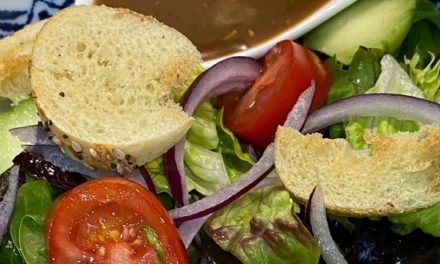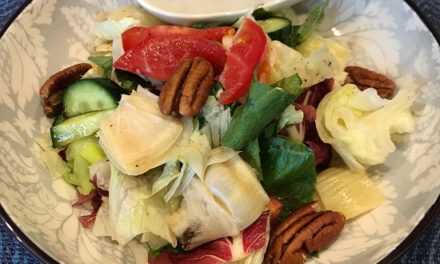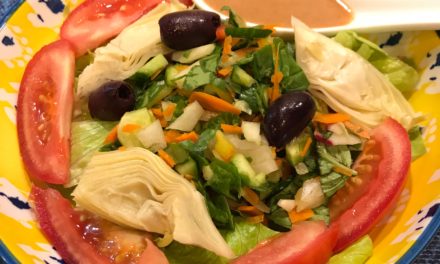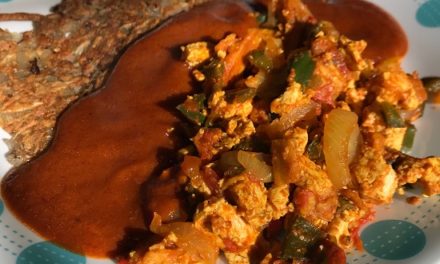Bibimbop is a Korean dish make with fresh vegetables served on rice. Original versions have some sort of meat, seafood and eggs but this is a WFPB version. Tofu can be added but it needs to be sauteed separately before adding it to the cooking vessel.
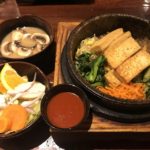
Bibimbop
A typical Bibimbop meal is served in a vessel called a "dolsot". It is filled halfway with cooked rice with vegetables added in. The rice is crisped up on the stove top and the vegetables are steamed from the cooking of the rice. The vegetables can differ depending on what is available. Although I tell how to prepare with tofu, I often make my bibimbop without any tofu, meat or egg. A bibimbop is often served with a light salad and soup.
Print Recipe
Equipment
- Dolsots or covered stove top vessel.
Ingredients
- 1 Carrot
- 4 Mushrooms
- 2 Cups Spinach
- 2 Green onions Or 1/4 sweet onion
- 1 Stalk Bokchoy Or 1 baby bokchoy
- 12 Snowpeas
- 1 Cup Frozen mixed vegetables
- 1 Cup Cooked rice
- 1/2 Cup Vegetable broth Optional
Tamari - ginger sauce
- 1/4 Cup Tamari
- 1/2 Tbsp Ginger Puree
- 1/2 Tbsp Chopped garlic
- 1/4 Tsp Roasted sesame oil
- 1 Tbsp Lime juice
- 1 Tbsp Honey
Pan fried Tofu
- 1/2 Tub extra firm tofu
- 2 Tbsp Tamari - ginger sauce
- 2 Tbsp Vegetable broth
Instructions
- Prepare Tamari - ginger sauce and tofu.
- Prepare rice per directions and noodles if using. See notes.
- Rinse frozen mixed vegetables to remove the freezer taste. Add mixed vegetables to cooked rice. Add Himalayan salt to taste if desired.
- Peel and slice vegetables of choice very thin as they will steam cook. All vegetables should be uniform in size.
- Snow peas should be de-stringed. I recommend slicing green onions on the diagonal. I prefer them on the edge of the dolsot to get a little sear.
- Lightly rub two dolsots or you cooking vessel(s) of choice with roasted sesame oil. Half fill with the rice mixture. Use a smaller cup of bowl to force the rice up on the sides of the vessel and leave you a "well" for your vegetables.
- Arrange your vegetables separately around the rice. Any vegetable that comes in contact with the dolsot itself might get a little sear. You may want to place your mushrooms and onions next to the edge above the rice and your tender greens, carrots or noodles more toward the center to be steamed.
- Add seared tofu if doing so.
- Add about 2 TBSP broth or water to the dolsots.
- Put the dolsots on a low flame and allow to cook for about 15 minutes.
- Remove from heat. Finish with a few drops of sesame oil, and tamari-ginger sauce. You may also use Gochuchang, a spicy Korean condiment found on your grocery shelf. Enjoy!
- In my house, I have the dolsots and wood holder for them. I serve them in the hot vessels.

Pan fried Tofu
- Remove tofu from tub. Place on a dish lined with a stack of 6 paper towels. Place a dish on top of tofu and weigh it down with a can of food or bowl of water. You want the pressure to remove extra water. Let it press for at least 30 minutes. See notes.
- Tofu can be baked, steamed or pan fried. In this photo, the tofu was pan fried in a little broth just to get a sear then and finished with tamari - ginger sauce. Add the slices on top of the vegetables in the dolsot.
Tamari - ginger sauce
- Add all ingredients together. If you want this thicker, you can lightly simmer it to reduce and thicken or add 1/2 Tbsp corn starch to the cold liquid and heat for 3 minutes on low.
Notes
 This is a Snap Pea Sheep recipe!
Freezing the tofu will completely change the texture and make it seem "meatier".
In this recipe, I give instructions to pan sear the tofu, but you could marinate the tofu in a mixture of Kala Namak, turmeric and a tablespoon of vinegar or lime juice to create a marinade of the seasoning. This takes the place of egg and can be placed on the tofu as-is or pan seared.
If you want noodles, you can cook soba, udon, ramen or rice noodles per direction and remove them from the water source before they are completely cooked through. The steam in the bibimbap will finish them off.
Experiment with different vegetables to provide different textures and flavors. They simply must be thinly sliced to be able to cook through from the steam.
Recommended vegetables:
Mushrooms, squash, daikon radish, cabbage, bok choy, spinach, escarole, cauliflower, rapini, carrots, potato cubes, bean sprouts, green or white onions, broccoli, green peas, snow peas, sugar snap peas, edamame, peppers, kimchi, sauerkraut, eggplant, celery, kolrabi, corn. Select at least 5.
You may finish with cilantro, basil or thai basil for a fresh finish!
This is a Snap Pea Sheep recipe!
Freezing the tofu will completely change the texture and make it seem "meatier".
In this recipe, I give instructions to pan sear the tofu, but you could marinate the tofu in a mixture of Kala Namak, turmeric and a tablespoon of vinegar or lime juice to create a marinade of the seasoning. This takes the place of egg and can be placed on the tofu as-is or pan seared.
If you want noodles, you can cook soba, udon, ramen or rice noodles per direction and remove them from the water source before they are completely cooked through. The steam in the bibimbap will finish them off.
Experiment with different vegetables to provide different textures and flavors. They simply must be thinly sliced to be able to cook through from the steam.
Recommended vegetables:
Mushrooms, squash, daikon radish, cabbage, bok choy, spinach, escarole, cauliflower, rapini, carrots, potato cubes, bean sprouts, green or white onions, broccoli, green peas, snow peas, sugar snap peas, edamame, peppers, kimchi, sauerkraut, eggplant, celery, kolrabi, corn. Select at least 5.
You may finish with cilantro, basil or thai basil for a fresh finish!


